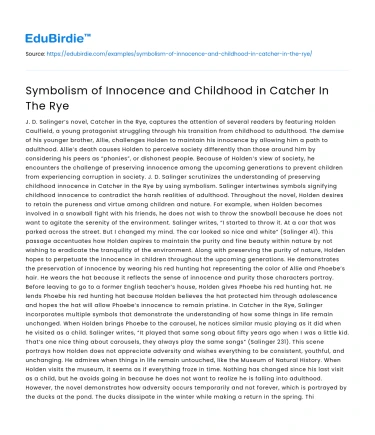J. D. Salinger’s novel, Catcher in the Rye, captures the attention of several readers by featuring Holden Caulfield, a young protagonist struggling through his transition from childhood to adulthood. The demise of his younger brother, Allie, challenges Holden to maintain his innocence by allowing him a path to adulthood. Allie’s death causes Holden to perceive society differently than those around him by considering his peers as “phonies”, or dishonest people. Because of Holden’s view of society, he encounters the challenge of preserving innocence among the upcoming generations to prevent children from experiencing corruption in society. J. D. Salinger scrutinizes the understanding of preserving childhood innocence in Catcher in the Rye by using symbolism.
Salinger intertwines symbols signifying childhood innocence to contradict the harsh realities of adulthood. Throughout the novel, Holden desires to retain the pureness and virtue among children and nature. For example, when Holden becomes involved in a snowball fight with his friends, he does not wish to throw the snowball because he does not want to agitate the serenity of the environment. Salinger writes, “I started to throw it. At a car that was parked across the street. But I changed my mind. The car looked so nice and white” (Salinger 41). This passage accentuates how Holden aspires to maintain the purity and fine beauty within nature by not wishing to eradicate the tranquility of the environment. Along with preserving the purity of nature, Holden hopes to perpetuate the innocence in children throughout the upcoming generations. He demonstrates the preservation of innocence by wearing his red hunting hat representing the color of Allie and Phoebe’s hair. He wears the hat because it reflects the sense of innocence and purity those characters portray. Before leaving to go to a former English teacher’s house, Holden gives Phoebe his red hunting hat. He lends Phoebe his red hunting hat because Holden believes the hat protected him through adolescence and hopes the hat will allow Phoebe’s innocence to remain pristine.
Save your time!
We can take care of your essay
- Proper editing and formatting
- Free revision, title page, and bibliography
- Flexible prices and money-back guarantee
In Catcher in the Rye, Salinger incorporates multiple symbols that demonstrate the understanding of how some things in life remain unchanged. When Holden brings Phoebe to the carousel, he notices similar music playing as it did when he visited as a child. Salinger writes, “It played that same song about fifty years ago when I was a little kid. That’s one nice thing about carousels, they always play the same songs” (Salinger 231). This scene portrays how Holden does not appreciate adversity and wishes everything to be consistent, youthful, and unchanging. He admires when things in life remain untouched, like the Museum of Natural History. When Holden visits the museum, it seems as if everything froze in time. Nothing has changed since his last visit as a child, but he avoids going in because he does not want to realize he is falling into adulthood. However, the novel demonstrates how adversity occurs temporarily and not forever, which is portrayed by the ducks at the pond. The ducks dissipate in the winter while making a return in the spring. This signifies how adversity occurs, however, it is not permanent. While reading the novel, the reader can examine how Holden denies to change throughout adversity because he believes it will obligate him into adulthood.
J. D. Salinger utilizes symbols contradicting Holden’s concern about preserving innocence. Holden witnesses several harsh incidents in his life that he finds traumatizing. For example, the tragic death of his peer, James Castle and profane graffiti among elementary school walls. Holden hardly knew James, however, he felt a sense of closeness with him because he died wearing his sweater. Salinger writes, “He had on this turtleneck sweater I’d lent him. All they did with the guys that were in the room was expel them. They didn’t even go to jail” (Salinger 188). This passage solidifies how Holden imagines himself dying, and his loss of innocence. He depicts how callous the world can behave, driving the weak people to grow miserable. Holden portrays the protection of innocence at this moment by having the desire to punish the folks who influenced James’ death. He wants to abolish the reality of adulthood and perpetuate purity in society, which is examined when Holden attempts to demolish profane graffiti. Holden encounters vulgar words written on elementary school walls and tries to rub it off as an attempt to preserve childhood innocence. He is in shock that there are humans in society promoting loss of virtue among youth. The profane graffiti represents Holden’s struggle to sustain innocence for all, and not only himself. Throughout the novel, there are symbols present accentuating Holden’s fight against the folks encouraging impurity.
Conclusion
Throughout Catcher in the Rye, Salinger incorporates several symbols intertwining to establish the theme of preserving purity and innocence. Holden does not aspire to adapt to adversity throughout life as he believes it will hinder innocence and open a door to adulthood. He knows he is experiencing adulthood, but he does not want to develop a mature mindset. Salinger assimilates small symbols and actions in the novel to manifest the importance of purity and virtue while demonstrating the understanding of how allowing a downfall in life is necessary. This assists readers in understanding the importance of downfall and how it can be used as motivation to put one’s life back together. Adjacent to the conclusion of the novel, Holden contemplates assembling his life back together. He educated himself thoroughly throughout his decline to conclude that it is required for him to accept the adult mindset. In society today, adversity will allow you an opportunity to grow as it is the bad times in your life that educate you more than the good times.






 Stuck on your essay?
Stuck on your essay?

